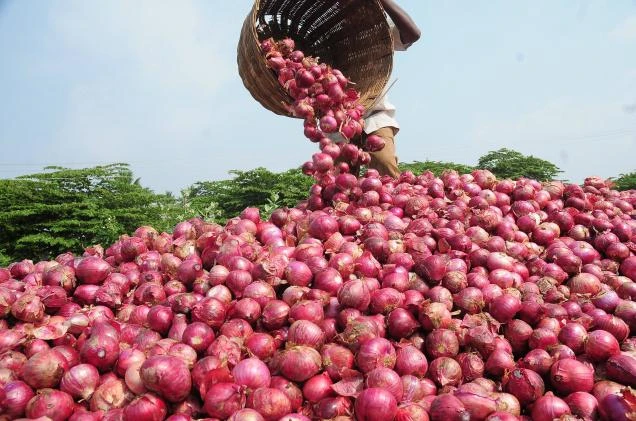In the last few years, onions have made headlines in Nigeria—but not for their flavour. In 2021, a major supply disruption from northern Nigeria shot the price up by more than 100% in some markets in southern markets. Flash floods in major growing areas like Kebbi and Sokoto worsened the shortages by the following year.
The root vegetables soon became associated with the label “the new gold” in some urban areas, as some households turned to alternatives like spring onions or local spices for a pungent flavour.
In 2025, the scarcity has only persisted—but caterers and food vendors may finally catch a break.
Truckloads of onions from the Republic of Niger have begun arriving in border towns in northern Nigeria.
The influx, already reaching major markets like Mile 12 in Lagos, Onitsha in Anambra State, and Port Harcourt in Rivers, is expected to correct the lingering scarcity and bring down prices of the essential kitchen staple.
From December 2024 until early 2025, onion prices soared, driven by increased demand and limited supply from the North. Some markets witnessed price increases of over 100 per cent, exposing once again the fragility of Nigeria’s onion supply chain.
By March 2025, however, prices began to ease, although they continued to remain well above pre-December levels. The market recorded a 44% year-to-date surge, with a big bag dropping from a January high of over ₦30,000 to around ₦26,000, while a small bag dipped from ₦21,000 to ₦19,000.
Despite the decline, costs remained burdensome for households owing to continued insecurity in farming regions, post-harvest losses, and logistic challenges.
A brief halt in supply to the South by the Onion Producers and Marketers Association of Nigeria (OPMAN) piled on the agony, leading to sharp fluctuations in both availability and pricing.
Farming hubs across the Republic of Niger are now helping to fill this gap. Compared with the Nigerian variety, Nigerien onions are better dried and have a longer shelf life, reducing spoilage, which makes them more attractive to traders and bulk buyers.
While Nigerian onions are usually cheaper at harvest, poor post-harvest handling inflates their eventual cost in urban markets, where spoilage and waste must be factored in.
With a glut of onions, imported onions from Niger are projected to be sold at cheaper prices
Currency dynamics between Nigeria and Niger further influence this shift. As of July 2025, the Nigerian naira traded at ₦1 to 0.37 West African CFA franc (XOF), giving Nigerian traders a purchasing advantage.
They can buy onions cheaply from Nigeriens and resell at a profit in local markets. However, parallel market rates and inflation at home could reduce the overall margin unless supply is steady and border logistics remain smooth.
In Nigeria’s fragile food economy, this seasonal dependence on Nigerien produce underscores a broader problem. While Niger’s contribution offers a quick fix, it doesn’t tackle Nigeria’s troubles of storage, drying, and preservation.
In 2023, onion shortages—caused by post-harvest losses, volatile pricing and insufficient storage infrastructure—cost Nigeria’s economy an estimated $420 million.
Without functional cold-chain systems, Nigeria loses a significant percentage of its perishable produce post-harvest due to heat, climate, poor logistics, seed fertility, and the overall lack of preservation methods.
If distribution from the Republic of Niger proceeds without disruption, onion prices may crash by as much as 20–30% in the weeks to come.
At best, the arrival of onions from the Republic of Niger may restore that sharp, spicy flavour to Nigerian kitchens—but not for so long unless local production improves.
In recent years, Nigeria has faced significant challenges with onion supply due to factors such as major disruptions, flash floods, and supply chain fragility, leading to a price surge of over 100% in some regions. The scarcity was exacerbated by post-harvest losses, logistical issues, and a temporary halt by the Onion Producers and Marketers Association of Nigeria. However, the recent influx of onions from the Republic of Niger is expected to alleviate the shortage, stabilize prices, and offer a temporary solution. Nigerien onions, known for their better drying and longer shelf life, provide an advantage over Nigerian varieties.
Despite this relief, Nigeria's dependency on imported onions highlights underlying issues such as inadequate storage, preservation, and cold-chain systems. These inefficiencies have led to significant economic losses estimated at $420 million annually due to onion shortages. While the current currency dynamics between Nigeria and Niger allow for profitable trading, improvements in domestic logistics and production are crucial for sustainable food security. The arrival of Nigerien onions might offer short-term relief, but failing to address local production challenges can prolong dependency and economic vulnerability.






